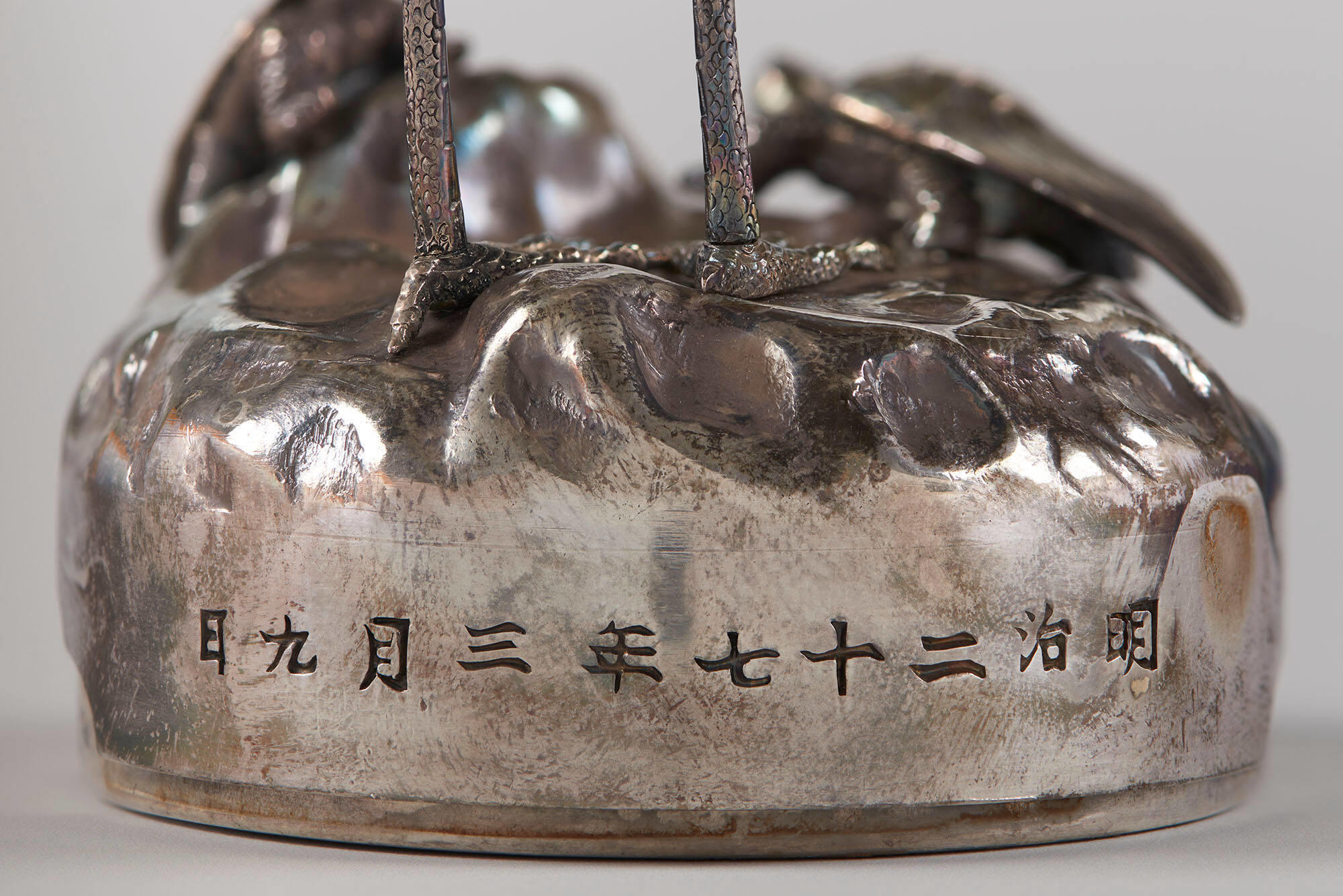In a case in the Little Salon, Isabella Stewart Gardner displayed an exquisitely crafted silver box of a crane and two turtles that was made for the Japanese Imperial Household.
The bottom of the box is dated March 9, Meiji 27 [1894], a date corresponding to the twenty-fifth wedding anniversary—also known as the silver wedding anniversary—of Japanese Emperor Meiji and Empress Shōken.

Isabella Stewart Gardner Museum, Boston (M18e44.a-b)
The inscription on the base of the Crane and Turtle Box, March 9, Meiji 27 [1894]
The Meiji Emperor’s and Empress Shōken’s marriage ceremony was conducted in private. However, the Imperial Household Agency and the oligarch bureaucrats saw the importance of public ceremonies and celebrations in establishing the legitimacy of monarchic heads of state. In emulation of traditions seen in Prussia, England, and Italy, the leadership of the Meiji Restoration (1868–1912) endeavored to fuse the personage of the emperor with the modern nation of Japan in the eyes and minds of the Meiji people.

Metropolitan Museum of Art, New York. The Elisha Whittelsey Collection, The Elisha Whittelsey Fund, 1986 (1986.1064a)
Uchida Kuichi (Japanese, 1844–1875), Mutsuhito, The Meiji Emperor, 1873. Albumen silver print from glass negative with applied color, 25.1 x 19.5 cm (9 7/8 x 7 11/16 in.)
The Imperial Household made substantial efforts to represent the marriage of the emperor and empress as an ideal and aspirational one, not unlike that of the kings and queens of Europe. In public appearances and official portraiture the emperor was represented with only the empress. Although images ignored the many concubines living within the walls of the Imperial Palace, they sometimes included the children of his consorts, including the crown prince and future Taishō emperor.

Art Gallery of Greater Victoria. Gift of Carol Potter Peckham (2012.026.001)
Unidentified artist, Portrait of Meiji Emperor and Family, 1903. Lithograph, 95.5 x 33.4 cm (37 ½ x 13 in.). The family members include Meiji Emperor Mutsuhito, the Empress, his son Yoshihito (becomes Emperor Taisho in 1912), daughter-in-law, his grandson Hirohito (becomes Emperor Showa in 1926), and his granddaughter.
In line with Meiji Restoration policies, the couple’s silver wedding anniversary was marked by grand public celebrations, military parades, musical performances, and a dinner for Meiji bureaucrats, foreign dignitaries, and their wives.
Art Gallery of Greater Victoria. Gift of Mr. Norman Christie (1989.034.008 a-c)
Utagawa Kokunimasa (Japanese, 1874–1944), Ceremony on the Occasion of the Meiji Emperor's Silver Wedding Anniversary, 1894. Woodcut, 35.1 x 69.7 cm (13 ⅞ x 27 ½ in.)
The Gardner Museum’s box is one of the carefully considered party favors for the state dinner. As per tradition, guests were given these boxes as imperial bonbonnières, small containers filled with sugar candies known as onshi no konpeitō. The box is decorated with a crane and two ancient turtles (minogame) which traditionally represent longevity and marital fidelity.

Isabella Stewart Gardner Museum, Boston (M18e44.a-b)
Japanese, Crane and Turtle Box, 1894. Silver with gold and lacquer, height: 10.5 cm (4 1/8 in.)
Aside from two others in private collections, all examples of this bonbonnière are in the collection of the Japanese Imperial Household. Kojiro Tomita (1890–1976), Isabella’s friend and a curator at the Museum of Fine Arts, Boston, gave this box to her sometime around the year 1909. Isabella displayed it in the Little Salon along with other objects commemorating her friendships.

